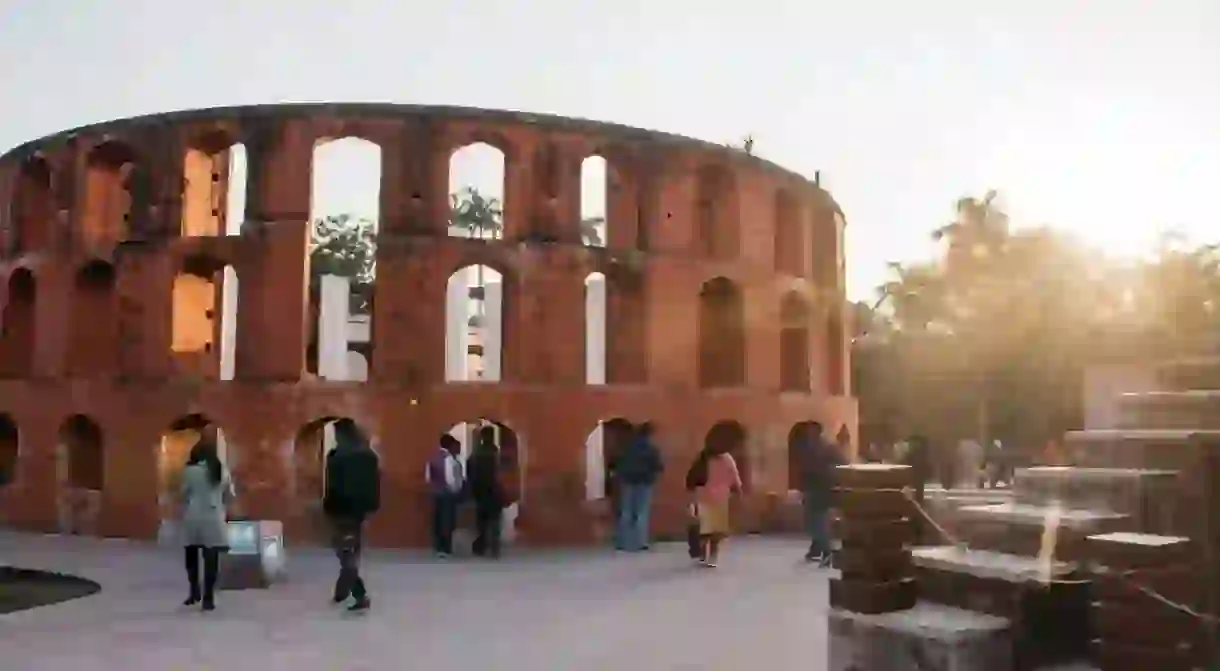Visit Jantar Mantra, Delhi's Surreal Monument to Astronomy

Jantar Mantar, an 18th-century astronomical laboratory built by the Rajput king of Jaipur, Maharaja Jai Singh II, stands as a proud testimony to ancient India’s scientific advancements.
Situated close to Connaught Place on Sansad Marg, Jantar Mantar is among Delhi’s most iconic landmarks. The laboratory, made of 13 red stone geometric instruments (or structures), was constructed in 1724 under the aegis of Mughal emperor Muhammad Shah to study the positions and trajectories of the sun, moon and the surrounding planets, and compile astronomical tables. This monument is strong evidence of the scientific intuition and cosmological concepts practised back in ancient India.


History of Jantar Mantar
Jai Singh II was the Hindu Rajput ruler of Amber, later known as Jaipur, which was a feudatory state of the Mughals. Not only was he an accomplished diplomat and a fine military man, but Jai Singh II was also known for his ingenuity. It is because of these skills that he became a favourite among the Mughal rulers.
It was Jai Singh II who persuaded Muhammad Shah to build the laboratory after Hindu and Muslim astrologers in the emperor’s court noticed some discrepancies in the planetary positions but could not reach a reconciliation based on their individual observations. At this point, Jai Singh II stepped in to create astronomical instruments that were both more accurate and efficient.
The monument in Delhi is among five Jantar Mantars built by Jai Singh II in the 18th century. The remaining observatories were constructed in Jaipur, Ujjain, Varanasi and Mathura. While four of these landmarks still stand today, the one in Mathura, unfortunately, disappeared in the 1850s.


The architecture
The observatory in Delhi consists of 13 astronomical instruments with the Samrat Yantra, Ram Yantra, Jai Prakash Yantra and Mishra Yantra being the principal devices among them. The designs of Jai Singh II were heavily influenced by the observatory in Samarkand, Uzbekistan built by 15th century Afghani ruler Ulugh Begh. However, the size of the monuments in India are comparatively large and therefore, much more accurate than its original inspiration.
The Samrat Yantra (supreme instrument) is a huge triangle that stands at 70 feet high and is 114 feet in the length at the base. This device provided the precise time of day and also measured the declination of heavenly bodies.
The Ram Yantra was designed to measure the altitude of stars using the latitudes and longitudes of the earth while the Jai Prakash Yantra was used to indicate the sun’s position at the time of the equinox. The Mishra Yantra, on the other hand, is a set of five instruments, which measured the longest and shortest days of the year. It could also determine the exact moment of noon in various cities across the world, regardless of their distance from Delhi.




The location
Jantar Mantar is conveniently located in the heart of Delhi, just next to Connaught Place, the area’s commercial hub. On a normal day, tourists can be seen marvelling the monument alongside locals taking a siesta under the shady trees.
But the usually tranquil Jantar Mantar also pulsates with activity on many occasions. Due to its close proximity to the Parliament of India, it has become the chosen setting for several peaceful protests by various groups from across the country, the chief among them being the 2011 anti-corruption movement, the Babri Masjid demolition protest and the demonstration by Tamil Nadu farmers in 2017. Most recently, around 100 members of the LGBTQ community gathered at the Jantar Mantar to celebrate the decriminalisation of homosexuality by the Supreme Court.


Jantar Mantar timings and ticket prices
The Jantar Mantar remains open every day from 6am to 7pm. The entrance fee for locals and foreigners is Rs 5 and (£0.05) Rs 100 (£1), respectively. The nearest metro station to the monument is Patel Chowk on the Yellow Line of the Delhi Metro.













